The smart HVAC controls market is projected to expand from USD 28.1 billion in 2025 to USD 160.3 billion by 2035, reflecting an addition of USD 132.2 billion at a CAGR of 19.0%.
The market progresses from USD 28.1 billion to USD 69.5 billion, adding USD 41.4 billion in value. Strong adoption across residential, commercial, and industrial spaces is driven by rising demand for energy efficiency, consumer preference for integrated comfort management, and stricter building codes. Rapid smart home penetration and favorable green-building policies further accelerate uptake.
In the second phase, the market advances from USD 82.4 billion to USD 160.3 billion, generating an additional USD 77.9 billion. This growth is underpinned by IoT-enabled HVAC solutions, AI-powered predictive maintenance, and cloud-based energy optimization platforms. Increasing integration with renewable energy systems and heightened deployment in offices, retail chains, hospitals, and educational institutions strengthen the trajectory.
By 2035, thermostats (61.8% share) remain the leading segment, while North America, Asia-Pacific, and Europe emerge as the most dynamic growth regions. The market’s expansion underscores HVAC’s central role in achieving decarbonized, intelligent, and energy-resilient building ecosystems.
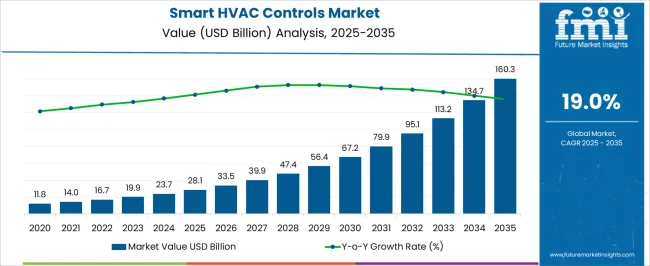
| Metric | Value |
|---|---|
| Smart HVAC Controls Market Estimated Value in (2025 E) | USD 28.1 billion |
| Smart HVAC Controls Market Forecast Value in (2035 F) | USD 160.3 billion |
| Forecast CAGR (2025 to 2035) | 19.0% |
The smart HVAC controls market is expanding rapidly as energy efficiency and smart home technologies become priorities for consumers and property developers. Growing awareness about reducing energy consumption and lowering utility bills has led to increased demand for intelligent control systems that optimize heating, ventilation, and air conditioning.
The integration of IoT and wireless connectivity has enabled remote monitoring and automation, enhancing user convenience and operational efficiency. Residential applications are driving much of this growth as homeowners seek to improve comfort while managing energy use more effectively.
Technological advancements in sensors, adaptive algorithms, and user-friendly interfaces have further accelerated adoption. Regulatory initiatives promoting energy conservation and smart building standards are expected to continue supporting market expansion. The market outlook remains strong, with thermostats emerging as the primary product segment due to their ease of use and pivotal role in temperature regulation.
The smart HVAC controls market is segmented by product, application, and region. By product, the market is divided into thermostats, smart air vents, and others. In terms of application, it is classified into residential, commercial, and industrial. Regionally, the smart HVAC controls industry is categorized into North America, Latin America, Western Europe, Eastern Europe, Balkan & Baltic Countries, Russia & Belarus, Central Asia, East Asia, South Asia & Pacific, and the Middle East & Africa.
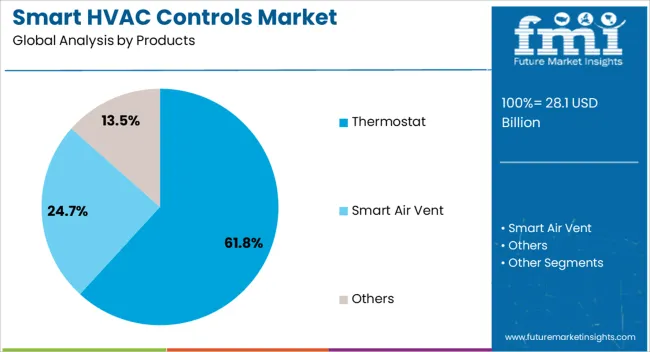
The Thermostat segment is expected to hold 61.8% of the smart HVAC controls market revenue in 2025, maintaining its dominance as the most widely used product. The popularity of smart thermostats has been driven by their ability to learn user preferences, adapt schedules, and provide remote control via mobile applications.
These devices contribute significantly to energy savings by optimizing heating and cooling cycles based on occupancy and weather conditions. Homeowners have favored thermostats for their simple installation and intuitive operation, making them a gateway product for smart home integration.
Continuous innovation in voice control compatibility and AI-driven analytics has kept this segment at the forefront of market growth. As residential demand for energy-efficient climate control rises, the Thermostat segment is expected to remain the key growth driver.
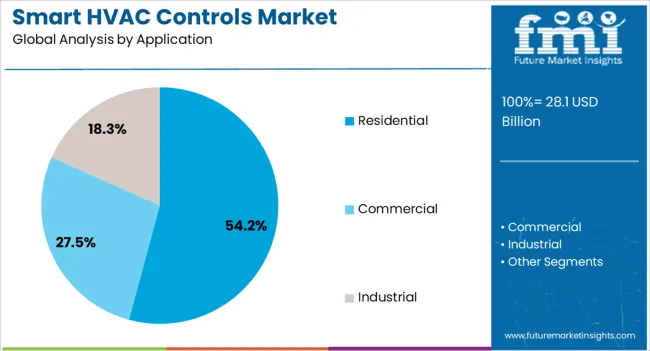
The Residential segment is projected to contribute 54.2% of the smart HVAC controls market revenue in 2025, securing its place as the leading application area. This segment’s growth has been fueled by increasing consumer interest in smart home technologies and energy management solutions.
Homeowners are adopting smart HVAC controls to enhance comfort, improve indoor air quality, and reduce energy costs. The rise in new residential constructions and retrofitting of existing homes with smart systems have further boosted demand.
Additionally, government incentives and building codes encouraging energy-efficient appliances have supported the residential segment’s expansion. The convenience of remote operation and integration with other smart home devices has appealed strongly to consumers. As energy efficiency remains a top priority in residential settings, this segment is expected to sustain its market leadership.
Smart HVAC controls are gaining prominence due to rising energy costs, regulatory compliance, ecosystem integration, and advanced predictive capabilities. Their role in optimizing efficiency and enhancing comfort ensures continued adoption across commercial, industrial, and residential spaces.
The adoption of smart HVAC controls has accelerated as building owners and facility managers seek solutions that reduce operational costs while ensuring consistent performance. Rising energy prices have pushed commercial and residential users toward automated temperature and ventilation systems that optimize consumption patterns. Smart thermostats and zoning solutions are designed to manage energy distribution efficiently, lowering monthly utility bills and improving return on investment. Governments in several regions are offering incentives to encourage the installation of energy-efficient HVAC systems, which further boosts demand. This driver is especially prominent in large-scale facilities such as hospitals, airports, and shopping centers, where energy savings from automated HVAC management significantly enhance profitability and long-term cost efficiency.
Regulatory frameworks focused on improving building performance are fueling smart HVAC control adoption. Mandatory compliance with efficiency standards across Europe, North America, and parts of Asia has created a strong need for HVAC systems capable of delivering measurable results. Programs such as LEED certifications and local building codes now prioritize intelligent control systems that monitor and optimize airflow, humidity, and heating. As energy audits become more stringent, property developers and operators are investing in advanced control platforms to remain compliant. These systems not only ensure regulatory approval but also increase the attractiveness of properties in competitive real estate markets. The regulatory push has emerged as a structural force sustaining long-term adoption.
Smart HVAC controls are increasingly integrated into broader building management ecosystems, enhancing interoperability across lighting, security, and occupancy management systems. Facility operators prefer unified platforms that centralize operations, reduce complexity, and improve responsiveness. With the rise of IoT-enabled devices, HVAC control systems are designed to interact seamlessly with other smart infrastructure elements, creating a holistic building performance framework. This integration allows real-time adjustments based on occupancy levels, weather patterns, and indoor air quality metrics. For businesses, it ensures enhanced comfort, reduced energy waste, and data-driven insights that inform operational strategies. The growing reliance on integrated smart systems highlights HVAC controls as a cornerstone of modern building efficiency strategies.
The evolution of control capabilities in HVAC systems has moved beyond basic temperature regulation to predictive and adaptive functionalities. Modern systems employ machine learning algorithms that analyze historical usage data, seasonal variations, and real-time occupancy to deliver optimized comfort with minimal manual intervention. Mobile connectivity enables facility managers and homeowners to adjust systems remotely, enhancing convenience and oversight. Predictive maintenance alerts also reduce downtime and extend equipment lifespan by detecting faults before they escalate. These advanced capabilities are reshaping user expectations, turning HVAC systems into proactive management tools rather than reactive utilities. Such developments have positioned smart HVAC controls as a transformative driver in building automation strategies.
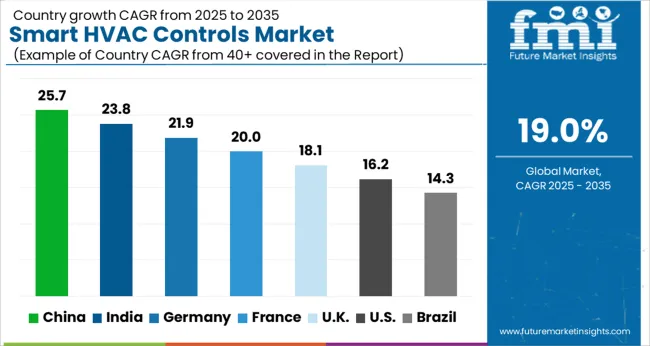
China leads with a CAGR of 25.7%, supported by large-scale adoption in commercial complexes, industrial facilities, and government-backed initiatives for smart buildings. India follows at 23.8%, fueled by expanding urban construction and rising installation in modern residential projects. France records a growth of 20.0%, driven by retrofitting projects and adoption in public facilities. The United Kingdom posts a CAGR of 18.1%, supported by demand in advanced building management systems. The United States grows at 16.2%, driven by replacement cycles in HVAC systems and integration with IoT-enabled platforms. The analysis spans more than 40 countries, with these markets acting as leading benchmarks for regulatory adaptation, digital building integration, and competitive strategy development in the global smart HVAC controls industry.
China is positioned as the leading growth hub for smart HVAC controls with a projected CAGR of 25.7% for 2025–2035, aligned with the global average of 25.7%. From 2020–2024, the CAGR stood at about 14.9%, when early adoption was mainly seen in large commercial projects and government-backed energy-efficient programs. The sharp increase arises from stronger adoption in residential smart homes, industrial plants, and public infrastructure, with state policies encouraging connected building management. Chinese manufacturers are scaling domestic production while integrating AI-based optimization and localized sensor technologies to strengthen exports and internal demand.
India is projected to grow at a CAGR of 23.8% between 2025–2035, outperforming the global average of 25.7% only marginally. From 2020–2024, CAGR was around 12.4%, as adoption was limited to luxury residential projects and large-scale IT parks. Growth acceleration is supported by wider penetration into mid-tier housing, healthcare facilities, and government offices, with vendors focusing on cost-sensitive solutions. Enhanced financing models and integration of mobile-enabled monitoring tools are stimulating adoption in second-tier cities. Indian firms and multinational players are investing in localized R&D to adapt products to varied climatic zones.
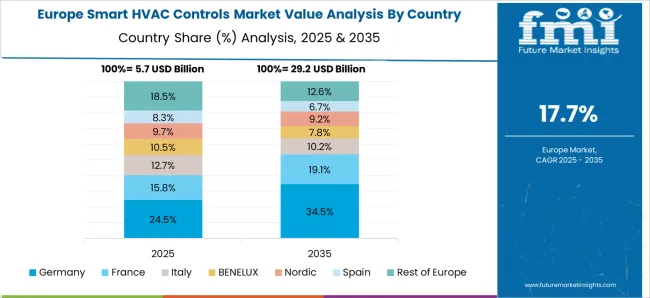
France is expected to register a CAGR of 20.0% during 2025–2035, below the global benchmark of 25.7%. From 2020–2024, CAGR was about 10.8%, reflecting slow entry barriers due to regulatory clearances and fragmented adoption. The acceleration comes from targeted retrofitting of public schools, hospitals, and municipal facilities, backed by European directives on energy consumption. A major driver is integration with centralized building management systems in commercial complexes. Vendors are collaborating with local contractors and energy service companies to expand reach.
The United Kingdom is forecast to post a CAGR of 18.1% between 2025–2035, falling below the global average of 25.7%. From 2020–2024, CAGR was approximately 9.2%, when adoption was concentrated in high-value commercial projects and premium housing estates. The climb to 18.1% is explained by broader acceptance of IoT-enabled systems in mid-range housing, integration with green building certifications, and steady replacement demand in commercial HVAC systems. Demand has expanded to industrial facilities adopting centralized monitoring platforms. Growth is also influenced by partnerships between multinational vendors and local distributors.
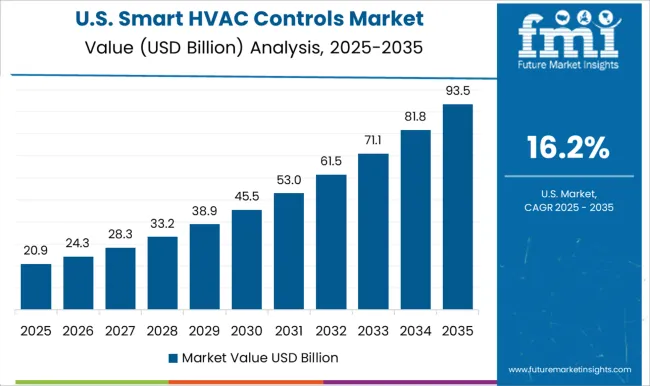
The United States is projected to achieve a CAGR of 16.2% during 2025–2035, below the global average of 25.7%. From 2020–2024, CAGR was about 8.1%, largely driven by replacement of outdated HVAC systems in corporate and residential sectors. The rise to 16.2% is explained by increasing integration with IoT platforms, energy compliance requirements, and demand in data centers requiring precise climate control. Regional utilities and contractors are offering rebate-linked programs, enhancing smart HVAC affordability. USA vendors focus on interoperability standards to strengthen adoption.

The smart HVAC controls market is shaped by strong competition among global and regional automation leaders, each emphasizing intelligent climate control, connectivity, and operational efficiency to address residential, commercial, and industrial requirements. Daikin Industries Ltd leverages its wide HVAC portfolio with integrated smart control platforms focused on energy optimization and indoor comfort.
Honeywell dominates with advanced building automation systems, offering cloud-connected thermostats and enterprise-level climate management. Johnson Controls and Schneider Electric focus on integrated building solutions, blending HVAC controls with broader facility management systems. Trane and Siemens maintain leadership through enterprise-wide climate automation, predictive maintenance, and IoT-enabled optimization across sectors.
| Item | Value |
|---|---|
| Quantitative Units | USD Billion |
| Products | Thermostat, Smart Air Vent, and Others |
| Application | Residential, Commercial, and Industrial |
| Regions Covered | North America, Europe, Asia-Pacific, Latin America, Middle East & Africa |
| Country Covered | United States, Canada, Germany, France, United Kingdom, China, Japan, India, Brazil, South Africa |
| Key Companies Profiled | Daikin Industries, Ltd., Delta Controls Inc., Distech Controls Inc., Ecobee Inc., Emerson Electric Co., Haier Group, Honeywell International Inc., Ingersoll Rand Inc., Johnson Controls International plc, KMC Controls, Inc., Lennox International Inc., LG Electronics Inc., Google (Nest), OJ Electronics A/S, Regin AB, SALUS Controls, Fr. Sauter AG, Schneider Electric SE, Trane Technologies plc, Siemens AG, Carrier Global Corporation |
| Additional Attributes | Dollar sales, share, regional growth patterns, emerging applications, regulatory impacts, distribution networks, customer adoption trends, competitor strategies, and technology integration opportunities. |
The global smart HVAC controls market is estimated to be valued at USD 28.1 billion in 2025.
The market size for the smart HVAC controls market is projected to reach USD 160.3 billion by 2035.
The smart HVAC controls market is expected to grow at a 19.0% CAGR between 2025 and 2035.
The key product types in smart HVAC controls market are thermostat, smart air vent and others.
In terms of application, residential segment to command 54.2% share in the smart HVAC controls market in 2025.






Our Research Products

The "Full Research Suite" delivers actionable market intel, deep dives on markets or technologies, so clients act faster, cut risk, and unlock growth.

The Leaderboard benchmarks and ranks top vendors, classifying them as Established Leaders, Leading Challengers, or Disruptors & Challengers.

Locates where complements amplify value and substitutes erode it, forecasting net impact by horizon

We deliver granular, decision-grade intel: market sizing, 5-year forecasts, pricing, adoption, usage, revenue, and operational KPIs—plus competitor tracking, regulation, and value chains—across 60 countries broadly.

Spot the shifts before they hit your P&L. We track inflection points, adoption curves, pricing moves, and ecosystem plays to show where demand is heading, why it is changing, and what to do next across high-growth markets and disruptive tech

Real-time reads of user behavior. We track shifting priorities, perceptions of today’s and next-gen services, and provider experience, then pace how fast tech moves from trial to adoption, blending buyer, consumer, and channel inputs with social signals (#WhySwitch, #UX).

Partner with our analyst team to build a custom report designed around your business priorities. From analysing market trends to assessing competitors or crafting bespoke datasets, we tailor insights to your needs.
Supplier Intelligence
Discovery & Profiling
Capacity & Footprint
Performance & Risk
Compliance & Governance
Commercial Readiness
Who Supplies Whom
Scorecards & Shortlists
Playbooks & Docs
Category Intelligence
Definition & Scope
Demand & Use Cases
Cost Drivers
Market Structure
Supply Chain Map
Trade & Policy
Operating Norms
Deliverables
Buyer Intelligence
Account Basics
Spend & Scope
Procurement Model
Vendor Requirements
Terms & Policies
Entry Strategy
Pain Points & Triggers
Outputs
Pricing Analysis
Benchmarks
Trends
Should-Cost
Indexation
Landed Cost
Commercial Terms
Deliverables
Brand Analysis
Positioning & Value Prop
Share & Presence
Customer Evidence
Go-to-Market
Digital & Reputation
Compliance & Trust
KPIs & Gaps
Outputs
Full Research Suite comprises of:
Market outlook & trends analysis
Interviews & case studies
Strategic recommendations
Vendor profiles & capabilities analysis
5-year forecasts
8 regions and 60+ country-level data splits
Market segment data splits
12 months of continuous data updates
DELIVERED AS:
PDF EXCEL ONLINE
Smart Meeting Pod Market Size and Share Forecast Outlook 2025 to 2035
Smart Electrogastrogram Recorder Market Size and Share Forecast Outlook 2025 to 2035
Smart Aerial Work Robots Market Size and Share Forecast Outlook 2025 to 2035
Smart Bladder Scanner Market Size and Share Forecast Outlook 2025 to 2035
Smart School Bus Platform Market Size and Share Forecast Outlook 2025 to 2035
Smart Home Wireless Smoke Detector Market Size and Share Forecast Outlook 2025 to 2035
Smart Bus Platform Market Size and Share Forecast Outlook 2025 to 2035
HVAC UV Sanitizer Market Size and Share Forecast Outlook 2025 to 2035
Smart Vision Processing Chips Market Size and Share Forecast Outlook 2025 to 2035
Smart Touch Screen Scale Market Size and Share Forecast Outlook 2025 to 2035
Smart Magnetic Drive Conveyor System Market Size and Share Forecast Outlook 2025 to 2035
Smart Wheelchair market Size and Share Forecast Outlook 2025 to 2035
Smart Mining Technologies Market Size and Share Forecast Outlook 2025 to 2035
HVAC Coil Coating Market Size and Share Forecast Outlook 2025 to 2035
Smart Parking Market Size and Share Forecast Outlook 2025 to 2035
Smart Digital Valve Positioner Market Forecast and Outlook 2025 to 2035
Smart Card IC Market Size and Share Forecast Outlook 2025 to 2035
Smart-Tag Inlay Inserters Market Analysis - Size and Share Forecast Outlook 2025 to 2035
HVAC Control System Market Size and Share Forecast Outlook 2025 to 2035
Smart TV Market Forecast and Outlook 2025 to 2035

Thank you!
You will receive an email from our Business Development Manager. Please be sure to check your SPAM/JUNK folder too.
Chat With
MaRIA